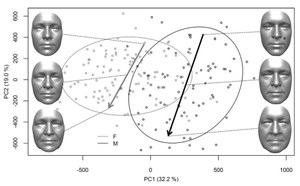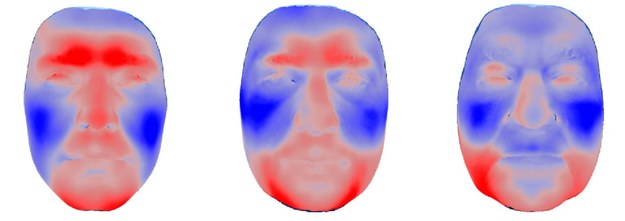Popular Science: Ageing is more pronounced in male face than in women
Morphology of the human face is determined mainly by the bone organization underneath. Facial muscles are attached to the bone surface and covered by subcutaneous fat and skin. During ageing, changes are visible on the soft tissue as well as on the hard skeletal tissue. Skin elasticity decreases, wrinkles accrue and the subcutaneous fat gradually decreases, which leads to the drop in the overall face volume and rise in the muscle tension. As a result, these changes influence remodelling process of the skeletal tissue. We are of course able to approximately recognize the age of an individual. However, are the ageing changes identical in men and women? Anthropologists from the 3D Laboratory of the Faculty of Sciences focused exactly on this question.
Sexual dimorphism of human face starts to be the most apparent from the adolescence. During this period, different hormones cause splitting of the male and female developmental trajectories. Consequently, male face is generally bigger, but the difference lies also in the shape component. Women tend to have higher and vaulted forehead, prominent cheek bones and narrow lower part of the face.
On the other hand, men have shorter eye distance, deeply deposited eyes, wider nose and more
 Main changes in human face related to aging. Results are from the Principal Component Analysis, which searches for the direction of the greatest variation in the sample (x axis). Aging sex dependent trajectories are plotted including face models for 20, 50 and 80 years of age. Source: Mydlová et al., 2015.
Main changes in human face related to aging. Results are from the Principal Component Analysis, which searches for the direction of the greatest variation in the sample (x axis). Aging sex dependent trajectories are plotted including face models for 20, 50 and 80 years of age. Source: Mydlová et al., 2015.
massive lower jaws. In addition, tissue proportions are also different, because men have a thinner layer of subcutaneous fat. But differences in males and females are also in the face development during life. Female face supposedly approaches male morphology with ageing (mainly during the menopause), which would lower sexual dimorphism. However, the progression of facial sexual dimorphism has been studied only in younger individuals by now. The wide age range comprising the whole adult stage of life is thus unique for this study.
The goals of this study were to analyse how the sexual dimorphism of the human face changes with age and whether the ageing trajectories are the same in men and women. Almost 200 three-dimensional facial scans were collected from people between 20 and 82-years-old. The scans were acquired by a special scanner deposited in the Department of Anthropology and Human Genetics. Scans were processed by geometric morphometric methods that are very popular in many scientific fields focused on object morphology.
These methods made it possible to visualize the senescence changes according to sex. The ageing trajectories share an almost identical direction in both sexes (Fig. 1), however, the male trajectory is longer, which means an increased manifestation of senescence changes. The most visible ageing changes were rounding of the face (especially widening of its lower part), increasing and deepening of wrinkles, nose widening and fragmentation of the lower jaw line (Fig. 1). Additionally, shape sexual dimorphism got lower in the regions of forehead, supraciliar arches, nose, cheeks and chin (Fig. 2). Despite this fact, the overall size of sexual dimorphism was increasing with age. It is caused by a substantial decrease in size of the female face, because of a fast decrease in subcutaneous fat. An interesting fact is that the most pronounced ageing changes were detected in the oldest men possessing the biggest faces.
 Comparison of the average male and female face in age categories 20–40, 41–60 and 61–82 years (red – male face lies before female one; blue – female face lies before male one). Source: Mydlová et al., 2015.
Comparison of the average male and female face in age categories 20–40, 41–60 and 61–82 years (red – male face lies before female one; blue – female face lies before male one). Source: Mydlová et al., 2015.
The presented article is a transversal study: each age category consists of different individuals, because it would be next to impossible to gather such records from one person covering the whole life. Although the results can be affected by secular trends, these changes are usually of a small extant. After all, this study can be very important in face modelling of long-term missing persons.
Rebeka Rmoutilová
Document Actions